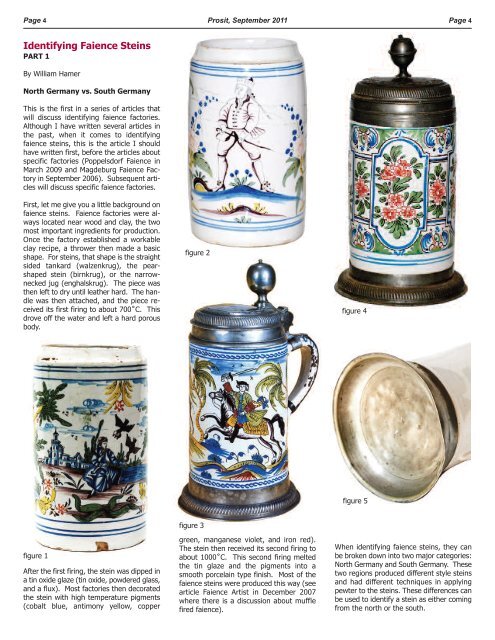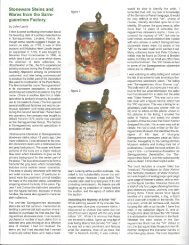Identifying Faience Steins. Part 1. By William ... - Ron Fox Auctions
Identifying Faience Steins. Part 1. By William ... - Ron Fox Auctions
Identifying Faience Steins. Part 1. By William ... - Ron Fox Auctions
You also want an ePaper? Increase the reach of your titles
YUMPU automatically turns print PDFs into web optimized ePapers that Google loves.
Page 4 Prosit, September 2011<br />
<strong>Identifying</strong> <strong>Faience</strong> <strong>Steins</strong><br />
PART 1<br />
<strong>By</strong> <strong>William</strong> Hamer<br />
North Germany vs. South Germany<br />
This is the first in a series of articles that<br />
will discuss identifying faience factories.<br />
Although I have written several articles in<br />
the past, when it comes to identifying<br />
faience steins, this is the article I should<br />
have written first, before the articles about<br />
specific factories (Poppelsdorf <strong>Faience</strong> in<br />
March 2009 and Magdeburg <strong>Faience</strong> Factory<br />
in September 2006). Subsequent articles<br />
will discuss specific faience factories.<br />
First, let me give you a little background on<br />
faience steins. <strong>Faience</strong> factories were always<br />
located near wood and clay, the two<br />
most important ingredients for production.<br />
Once the factory established a workable<br />
clay recipe, a thrower then made a basic<br />
shape. For steins, that shape is the straight<br />
sided tankard (walzenkrug), the pearshaped<br />
stein (birnkrug), or the narrownecked<br />
jug (enghalskrug). The piece was<br />
then left to dry until leather hard. The handle<br />
was then attached, and the piece received<br />
its first firing to about 700˚C. This<br />
drove off the water and left a hard porous<br />
body.<br />
figure 1<br />
After the first firing, the stein was dipped in<br />
a tin oxide glaze (tin oxide, powdered glass,<br />
and a flux). Most factories then decorated<br />
the stein with high temperature pigments<br />
(cobalt blue, antimony yellow, copper<br />
figure 2<br />
figure 3<br />
green, manganese violet, and iron red).<br />
The stein then received its second firing to<br />
about 1000˚C. This second firing melted<br />
the tin glaze and the pigments into a<br />
smooth porcelain type finish. Most of the<br />
faience steins were produced this way (see<br />
article <strong>Faience</strong> Artist in December 2007<br />
where there is a discussion about muffle<br />
fired faience).<br />
figure 4<br />
figure 5<br />
Page 4<br />
When identifying faience steins, they can<br />
be broken down into two major categories:<br />
North Germany and South Germany. These<br />
two regions produced different style steins<br />
and had different techniques in applying<br />
pewter to the steins. These differences can<br />
be used to identify a stein as either coming<br />
from the north or the south.
Page 5 Prosit, September 2011<br />
figure 6<br />
NORTH GERMANY<br />
Figures 1 & 2 show two typical steins produced<br />
in the north. They feature steins<br />
without pewter work to better show this<br />
type of stein body. The bottom of this steins<br />
have straight sides and the tops are indented.<br />
Figure 3 & 4 is of two steins with<br />
typical pewter work. The top of the steins<br />
have a lid ring which fits around the indentation<br />
at the top of the steins body along<br />
with a lid that closes over itself. Figure 5<br />
shows the bottom of a typical pewter base.<br />
The pewter base is straight at the sides and<br />
it usually has a full pewter base underneith,<br />
which would cover up any markings on the<br />
bottom of the stein. This is one reason why<br />
identifying faience can be difficult when the<br />
base pewter work covers up any markings<br />
that may be on the bottom of the stein it<br />
The lid ring and the pewter base are attached<br />
to the stein using pitch. Over time<br />
this pitch dries out and due to the straight<br />
sided design at the bottom of the stein<br />
body, the pewter base can come loose and<br />
is often missing. The stein in figure 6 has<br />
lost its base because of this manufacturing<br />
flaw.<br />
figure 7<br />
figure 8<br />
Page 5<br />
SOUTH GERMANY<br />
A typical south German stein is shown in<br />
Figure 7. The stein body is straight at the<br />
top and the bottom is flared out. This stein<br />
does not have a lid ring but other south<br />
German steins may have a lid ring, as<br />
shown in Figure 8. The pewter at the bottom<br />
of the stein is a ring which fits over the<br />
flare at the base of the stein body. This<br />
figure 9<br />
ring only fits around the edge of the stein<br />
and does not cover the bottom of the stein<br />
body, so any markings on the bottom of the<br />
stein are visible as shown in Figure 9.<br />
Summary<br />
So, by looking at the stein design and the<br />
pewter work you can identify whether a<br />
faience stein is from the north or the south.<br />
Now the hard part begins in trying to identify<br />
the individual factories. In the next several<br />
articles I will discuss specific factories<br />
and give you help in identifying their steins.<br />
I will address the factories that I have studied<br />
and identify specific decoration traits<br />
that I have noticed. There should be another<br />
6-10 parts to this series and I hope to<br />
have one article in each of the next several<br />
Prosits until finished.<br />
There are two charts at the end of this article<br />
that list the NORTH GERMAN and the<br />
SOUTH GERMAN factories. Opposite each<br />
chart are photos of various faience stein<br />
from each region. The charts list the factories<br />
and their manufacturing dates, pewter<br />
base design, and the number of steins that<br />
I have in my faience stein database. I have<br />
been tracking faience stein that come up in<br />
auctions both in the USA and Germany as<br />
well as eBay, going back to the mid ‘90s.<br />
Currently there are over 8100 steins in my<br />
database, which includes delft and Austrian<br />
faience. So the factory numbers will give<br />
you an idea of how rare a particular factory<br />
may be. The pewter base information is<br />
SSFPB – straight side full pewter base and<br />
FFR – flared foot ring.
Page 6 Prosit, September 2011 Page 6<br />
Factory<br />
Northern German <strong>Faience</strong> Factories<br />
North Germany (Norddeutsch)<br />
Central German<br />
Berlin (1678-1768)<br />
Braunschweig (1707-1807)<br />
Frankfurt a.d.Oder (1763-1795)<br />
Hannoversch-Munden (1732-1854)<br />
Magdeburg (1754-1785) White<br />
Creamware<br />
Potsdam (1739-1796)<br />
Rheinsberg (1762-1866)<br />
Wrisbergholzen (1735-1834)<br />
Thuringen<br />
Abtsbessingen (1739-1790’s)<br />
Coburg (1739-1786)<br />
Dorotheenthal (1707-1803)<br />
Dresden (1708-1784)<br />
Erfurt (1717-1792)<br />
Gera-Untermhaus (1750-1780)<br />
Halle a.d. Saale (1736-1773)<br />
Rudolstadt (1720-1809)<br />
Zerbst (1721-1796)<br />
Thuringen Region<br />
Eastern German<br />
Glinitz (Zborowski) (1767-?)<br />
Proskau (1769-1793)<br />
Seas<br />
Kellinghusen (1763-1846)<br />
Kiel (1763-1787)<br />
Lesum (1756-1800)<br />
Stockelsdorf (1772-1786)<br />
Pewter Base<br />
SSFPB<br />
SSFPB<br />
SSFPB<br />
SSFPB<br />
SSFPB<br />
SSFPB<br />
SSFPB<br />
SSFPB<br />
SSFPB<br />
SSFPB<br />
SSFPB<br />
SSFPB<br />
SSFPB<br />
SSFPB<br />
SSFPB<br />
SSFPB<br />
SSFPB<br />
SSFPB<br />
SSFPB<br />
SSFPB<br />
???<br />
SSFPB<br />
SSFPB<br />
???<br />
SSFPB<br />
???<br />
Total<br />
62<br />
934<br />
185<br />
74<br />
18<br />
407<br />
114<br />
84<br />
17<br />
34<br />
1<br />
1013<br />
6<br />
2<br />
85<br />
63<br />
318<br />
3<br />
2<br />
2<br />
7<br />
525<br />
116<br />
0<br />
116<br />
6<br />
1<br />
0<br />
5<br />
0<br />
Berlin<br />
Berlin<br />
Braunschweig
Page 7 Prosit, September 2011 Page 7<br />
Potsdam<br />
Erfurt<br />
Dorotheenthal<br />
Thuringen<br />
Dresden<br />
Thuringen<br />
Magdeburg Thuringen<br />
Proskau<br />
Hannover-Munden<br />
Rheinsberg<br />
Braunschweig
Page 8 Prosit, September 2011 Page 8<br />
Factory<br />
Southern German <strong>Faience</strong> Factories<br />
South German (Suddeutsch)<br />
Wester German<br />
Florshein (1765-1922)<br />
Frankfurt am Main (1666-1772)<br />
Fulda (1741-1758)<br />
Hanua (1661-1806)<br />
Hochst (1746-1758)<br />
Kassel (1680-1780)<br />
Kelsterbach (1758-1835)<br />
Koln/Cologne (1770-?)<br />
Offenbach (1739-1807)<br />
Poppelsdorf (1755-1900)<br />
Wiesbaden (1770-1797)<br />
Wurttemberg<br />
Crailsheim (1715-1827)<br />
Göppingen (1741-1778)<br />
Ludwigsburg (1734-1824)<br />
Schrezheim (1752-1852)<br />
Baden<br />
Durlach (1723-1847)<br />
Mosbach (1770-1828)<br />
Upper Plains<br />
Amberg (1759-1910)<br />
Ansbach (1710-1804)<br />
Bayreuth (1714-1835)<br />
Nurnberg (1712-1840)<br />
Sulzbach (1752-1774)<br />
Swaben<br />
Augsburg (1747-1749)<br />
Donauworth (1740-?)<br />
Friedberg (1754-1768)<br />
Goggingen (1748-1752)<br />
Kunersberg (1745-1768)<br />
Oettingen-Schrattenhofen (1735-1830)<br />
Oettingen-Tiergarten<br />
Schrattenhofen<br />
Swaben Region<br />
Upper Rhine<br />
Hagenau (1724-1781)<br />
Strassburg-Hagenau (1709-1779)<br />
Niederweiler (1755-1827)<br />
Pewter Base<br />
FFR<br />
FFR<br />
FFR<br />
FFR<br />
FFR<br />
FFR<br />
???<br />
FFR<br />
FFR<br />
FFR<br />
FFR<br />
FFR<br />
FFR<br />
FFR<br />
FFR<br />
FFR<br />
FFR<br />
FFR<br />
FFR<br />
FFR<br />
FFR<br />
FFR<br />
FFR<br />
FFR<br />
FFR<br />
FFR<br />
FFR<br />
FFR<br />
FFR<br />
FFR<br />
Total<br />
150<br />
798<br />
36<br />
182<br />
3<br />
527<br />
2<br />
2<br />
11<br />
6<br />
19<br />
6<br />
4<br />
1260<br />
309<br />
4<br />
14<br />
933<br />
75<br />
71<br />
4<br />
1861<br />
30<br />
384<br />
706<br />
735<br />
6<br />
342<br />
7<br />
3<br />
30<br />
14<br />
153<br />
71<br />
27<br />
32<br />
5<br />
0<br />
0<br />
0<br />
0<br />
Frankfurt Main<br />
Crailsheim<br />
Oettingen-Schrattenhofen
Page 9 Prosit, September 2011 Page 9<br />
Durlach Bayreuth Bayreuth Nurnberg<br />
Crailsheim Ansbach Ansbach<br />
Schrezheim<br />
Schrezheim<br />
Koln/Cologne<br />
Nurnberg<br />
Nurnberg



